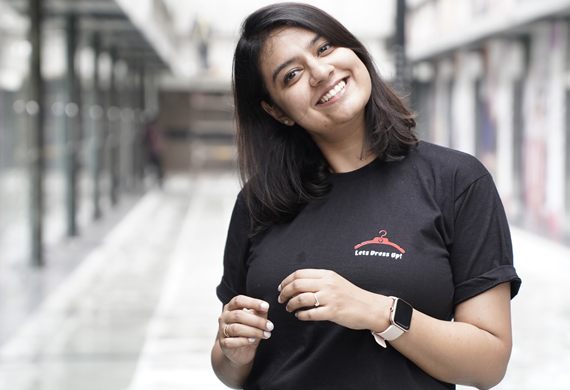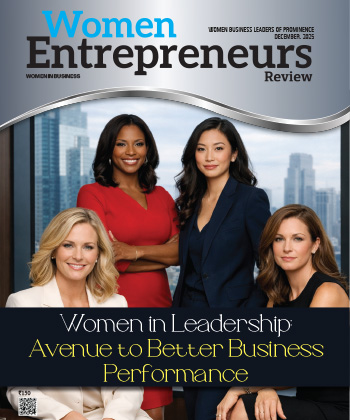
This Doctor Turned Entrepreneur is Fixing Women's Fashion Woes through Technology
By: WE Staff
The rise of e-commerce has transformed the way India shops, especially for clothing. An Indian consumer today has uncountable shopping options at the click of a button. However, incorrect sizing has always been a pain point for customers and e-commerce players alike. Indian fashion is quite high at~30%-40%.
It took a woman’s real-life experience to come up with a solution to this ordeal. Dr. Drishti Anand co-founded, the fashion-tech startup LetsDressUp (LDU) along with her husband, Aditya Balani. LDU aims to transform the $100 billion Indian fashion industry from a highly polluting, low-retention, and high-product returns business to a near zero-waste, sustainable, high customer-retention sector. LDU is also the first company to create the Indian size chart.
Built on the trifecta of innovation, market insight, and technology, LDU is backed by Indian VCs such as Titan Capital, and other marquee angels like Sweta Rao, etc., in various capacities. The platform is now set to reach the INR 100-crore annualized revenue mark within the next 6-9 months and raise the next round of funding soon.
The Women Entrepreneur India magazine team spoke to Dr. Drishti about various aspects of the startup and her journey from being a doctor to an entrepreneur.
How was the seed of the idea for LetsDressUp planted in your mind? Was it based on your personal experiences as a shopper, or was it an observation of the Indian fashion retail landscape? Please take us through that journey.
I am a doctor-turned-entrepreneur who has worked in some of the country's most reputed and busiest hospitals like Medanta the Medicity Gurgaon, and Safdarjung Delhi. Having always believed in the power of dressing up, I have always advocated for the fact that when a woman is dressed in the right outfit, she is more confident and in control of her persona.
However, finding the right outfit that fit and spoke to me well was always a challenge. I used to return half of what I bought or spent hours trying to get the outfits altered to my preference and size. I discussed this daily struggle with my husband, Aditya, who was working closely with the fashion industry, solving CXO-level problems. He further told me I was not alone in my struggle and that at least two-thirds of the Indians were unsatisfied with the clothes they bought.
The return rate in the fashion industry is also the highest at ~30%-40%. Understanding this gap was the eureka moment. Having faced the pain point myself and Aditya having scaled businesses, we realized that we were the right combination of the right and left sides of the brain to go after this problem, and thus LetsDressUp (LDU) was born.
What problem is your fashion-tech company looking to solve and how does it work?
LetsDressUp is the most inclusive brand for women of Bharat. For the women who have always struggled to find their fit, LDU offers sizes from XS to 8XL, which even the most well-known brands don't provide, and our sizes are based on the Indian size chart.
LDU is the first company to develop a size chart based on real-time measurements of 3000+ Indian women, which is getting better daily with each outfit sold. Fashion is a $100 billion market in India and over $1 trillion globally, yet it is broken across all segments. Broadly there are 3 segments: consumers, manufacturers, and environment.
Consumers: Almost 2 out of 3 Indians are unhappy with the clothes they buy and struggle to find the size in their desired styles. As a result, the rate of return in the fashion industry is the highest at ~30-40%.
Manufacturers: Due to large credit cycles, manufacturers face a huge working capital issue. Also, ~50% of capacity still needs to be utilized at any given point of time in a year.
Environment: Almost ~65% of clothes burnt or dumped in the first year itself; ~10% of carbon emissions and ~20% of waste water come from the fashion industry.
LDU is solving these problems in a full-stack manner across all three segments.
Consumers: At LDU, we have built India’s first size chart, and we are the most inclusive brand offering XS-8XL, with 100s of new styles every week at a price of less than INR 1000.
Manufacturers: We have worked closely with manufacturers and have actively changed the quarterly to half-yearly to weekly payment cycles. By doing this, we have solved the working capital issues while helping them better utilize their unutilized capacity.
Environment: We at LDU are building with a zero-dead inventory model. We leverage technology to ensure that the design-to-execution cycle is less than a week, compared to the industry average of 3-4 months. We also use technology to track the unutilized capacity and help them better utilize it. In this process, we do not create anything the users never really wanted and operate with a zero-dead, environmentally conscious inventory model.
You say your brand LetsDressUp is a brand for Bharat. Can you elaborate on this?
At LDU, our core mantra is #inclusivitymatters. We are building not just for the top 1% audience in the Tier 1 cities of India but for every woman in any nook and corner of the country. We receive over 50% of the orders from non-Tier-1 cities, which speaks volumes about brand love. Most of our outfits are priced at <₹999 so that they are accessible to all. We have sizes from XS to 8XL based on the Indian audience, thereby catering to the requirements of Indian women who face the challenge of finding the right fit since all the garments in the market are made as per the foreign size chart. Hence, we are empowering every Indian woman to feel comfortable and confident in her style in her size.
How has LetsDressUp's journey been since its inception? What is the roadmap set for the venture's next growth phase?
The Indian textile and apparel market is expected to reach $387.3 billion by 2028, exhibiting a growth rate (CAGR) of 14.59% from 2023 to 2028. We have turned EBITDA+ and have crossed our ~15 crores annualized revenue mark. Growing at ~50% MoM, we are on our way to reaching our next milestone of ~100Cr mark in the next ~12 months and 1000CR in the next 3-4 years, eventually headed towards IPO. We are backed by the most popular VCs like TITAN capital and numerous marquee angels like Sweta Rau, Kearney India Head, Kaushika Madhavan, and various senior partners from Kearney and McKinsey in various capacities.
You were a doctor before turning into an entrepreneur. How has this transition been for you? If given a choice, what would you do differently?
Being a doctor, I come from an industry that has produced the least number of entrepreneurs. Despite overcoming enormous pressure and warnings from all quarters, including my family, I persevered with my vision of solving a problem that affects almost every modern woman in India. I went from healing with medications to healing with styles. Given a choice, I would opt to go the unconventional way time and again.
You chose the unconventional path. What are the lessons you would like to share with women who are reading you right now?
Our motto at LDU is to be #bemoreofyou, which I truly believe in, and do what you love the most. Second, be bold and take the leap of faith. There will be periods of self-doubt, but those shall pass. Lastly, support other women and see the power of the community.
You co-run the company along with your husband, Aditya Balani. How has the partnership worked so far? What tips can you share for entrepreneurs to handle relationships successfully?
Aditya and I have known each other since our school days. I am a people person, whereas Aditya is more of a numbers guy. Thus, we complement each other’s skill sets and form a great team at the office and at home too. Working with my partner is one of the best things that has happened to me. Celebrating our success and overcoming failures together has only strengthened our bond. LDU is our first baby, and we are nurturing it together. Just like in any other relationship, open-hearted and honest communication also plays a crucial role here. Never ignore each other and put in place conflict resolution mechanisms.
Most Viewed
- 1 Women's Health Startup HerMD Closing Doors Amid Industry Challenges
- 2 5 Famous Women in Indian Armed Forces
- 3 Saudi Women No longer Require Male Permission for Clothing Choices, says Prince MbS
- 4 Kolkata Medtech Startup Innovodigm Raises Rs 5.5 Crore Seed Funding Led by IAN Group
- 5 Yamunanagar's Kashish Kalra Honoured after Securing 111th Rank in UPSC Civil Services Exam
- 6 Madurai Appoints Its First Woman Corporation Head
- 7 IAS Vijayalakshmi Bidari Appointed as the new Nagpur Divisional Commissioner
- 8 American Entrepreneur Lucy Guo Overtakes T Swift to become Youngest Female Billionaire
- 9 ICC Women's World Cup 2025 Trophy Showcased at Indore's Holkar Stadium
- 10 Aparna Saxena's Beauty Venture AntiNorm Launches in India
- 11 Vidya Nataraj Co-Founded BlueStone Jewellery & Lifestyle files IPO
- 12 5 Women Freedom Fighters of India
- 13 Dr. G Krishnapriya appointed as CEO for Trichy
- 14 M3M & Sirona Partner to Introduce Menstrual Hygiene Vending Machines in 15 Locations
- 15 Punjab Govt launches SHE Cohort 3.0 Supporting Tech-led Women Startups
- 16 Indian origin Lawyer, Sweena Pannu appointed as the US New Superior Court Judge
- 17 The Aurora Tech Award recognizes 4 Indian Women-led Startups
- 18 Kerala's Republic Day parade featured an all-female tableau
- 19 Manisha Kabbur Becomes Karnataka's First Woman International Karate Coach
- 20 Director K. S. Ravikumar's Daughter Maalica Ravikumar Launches Life Coaching Company 'Evergrowth Academy' for Women
- 21 Leezu's Raises Pre-Seed Funding to Accelerate Growth in Sexual Wellness Industry
- 22 Sattu: Super-easy summer drink for PCOS gut healing
- 23 Swathi Nelabhatla creates Sitha App, India's First Women-Exclusive Gig Platform
- 24 7 Timeless Female Kathak Dancers & their Iconic Legacies
- 25 Meet 7 Iconic Women Architects of Modern India & their Most Impactful Work
- 26 This Woman-led Insuretech Startup is Helping Bridge the Education Financing Gap in India
- 27 Women Leaders Share Lessons Learnt from India Women's WC Win
- 28 5 Enterprising Women Founders Powering Singapore's Tech & Innovation Landscape
- 29 4 Women. 4 Stories. One Vision for Smarter, Stronger Healthcare
- 30 Global Gender Gap Narrows to 68.8%, But Full Equality 123 Years Away: WEF Report 2025
- 31 Changemakers: 7 Women Entrepreneurs Taking the Make in India Movement Forward
- 32 Meet Lucy Guo, The Youngest Self-Made Female Billionaire Disrupting Tech
- 33 How Women are Driving India's Festive Online Shopping Surge






